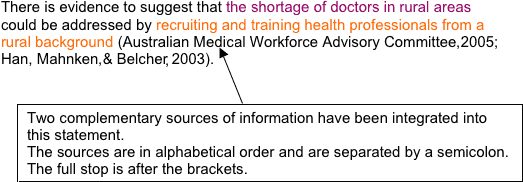Previous page
Task B: Citing authorities in your textNext page
Task D: Paraphrasing (writing in your own words)Index page
Workshops indexTask C: Citing several sources at once
Summary
In your writing, you will integrate information from a range of sources. This requires you to think about the meaning of what you read, and to summarise and integrate the ideas from your sources into your own writing. When you do this, you must use the correct referencing conventions to acknowledge the sources of your information.
You will learn:
- Rules for citing several sources at once
- How to combine and reference information taken from more than one source
Rules for citing several sources at once
Sometimes several authors or research studies will support the same idea or findings. It gives credibility to your writing if you can cite more than one source to support your argument. Learn the rules for citing several sources at once by answering the quiz below.
Activity
Example: Citing several authors
Several studies have proposed a relationship between stressful life events and a wide variety of physical and psychiatric disorders (deAnda et al., 1997; Finlay & Zigmond, 1997; Mandle et al., 1995).
(Adapted from Crisp & Taylor, 2005, p. 589)
How to combine and reference information taken from more than one source
Sometimes several authors or research studies will provide complementary information. For instance, one source of information might present a problem, while another might suggest a solution to the problem. Try the exercise below to combine two complementary sources of information.
Activity
In your essay you will write about the need to address the shortage of health professionals in rural and remote areas. You are going to read two sources of information on the topic and use this information to answer the question. You will need to reference both sources at once.
Reading 1
The shortage of health professionals in rural and remote areas has been a serious concern. Rural health professionals are constantly leaving for urban practice. The training and recruitment of health professionals who may be prepared to serve rural communities for a lengthy period is a challenge if a nation is committed to the provision of equitable health services to its rural population. (Han, G., Mahnken, J., & Belcher, S. (2003). More rural and Aboriginal students for health related university courses – are we making progress? Australian Health Review, 26 (2) 73-77).
This reading focuses on:
Reading 2
A positive association was observed between preference to practice in a rural/remote location and rural background. Of the doctors with a rural background, 28% indicated a preference for working in a rural location in the long term, compared with 10% of doctors with an urban background. (Australian Medical Workforce Advisory Committee 2005, Doctors in vocational training: rural background and rural practice intentions, Australian Journal of Rural Health, 13, 14-20).
This reading focuses on:
If you combine the problem identified in Reading 1 and the solution identified
in Reading 2, you can summarise the main ideas as a single statement using
both sources of information:



